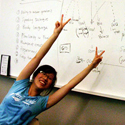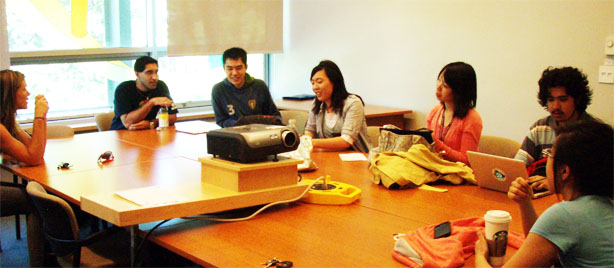Team:British Columbia/Notebook/Week 3
From 2011.igem.org
| (22 intermediate revisions not shown) | |||
| Line 1: | Line 1: | ||
{{Template:Notebook}} | {{Template:Notebook}} | ||
| + | <html> | ||
| + | <style> | ||
| + | #bod {width:935px; float:left; background-color: white; margin-left: 15px; margin-top:10px;}</style> | ||
| + | <div id="bod"><b>Week 3: June 19-25</b> <html><a name="w3"></a></html> | ||
| - | ==June | + | ==Lab Meeting - June 20== |
| - | + | [[File:Ubcwk8Meet.JPG | frame]] | |
| - | + | Gurpal gave a modeling presentation - indicating the parameters needed and how wet lab data will be incorporated into the model. | |
| - | + | For our human practices project, Laura contacted Science World and arranged a presentation and workshop on synthetic biology in September. | |
| - | + | ||
| - | Laura | + | The team agreed that the amount of e-mail is ridiculous; everyone is getting lost! Laura developed e-mail lingo to organize the e-mails and help direct e-mail traffic to the appropriate people. |
| - | + | <br><br> | |
| - | + | ==Competent Cells== | |
| - | = | + | Our team was low on competent cells so making more of them was a priority this week. Rafael started an overnight culture of DH5alpha <i>E. coli</i>. Gurpal then took charge of making competent cells. It was his first time making competent cells (and performing his own iGEM laboratory work for the first time) (and he knew the group needed them - the pressure was on). Gurpal made and autoclaved 1L of LB broth while filter sterilizing 0.1M CaCl2. Then, he grew the overnight culture in LB broth in a 30oC incubator until OD600nm = 0.401. Next the mixture was spun down using a centrifuge. The pellet was washed in CaCl2 and the cells were kept on ice for 40 minutes. They were spun down again and stored at 4oC overnight. The next day, Laura and Gurpal started an assembly line and stored over 120 aliquots of competent cells in glycerol solutions. The cells were finally stored in a -80oC freezer for later use. |
| - | + | Sam and Gurpal also made LB agar plates with ampicillin antibiotic. First, Gurpal prepared a stock ampicillin solution of 100 mg/mL. He added ethanol to the solution so that the ampicillin would not freeze in the -20 degree freezer - so it could be used immediately during an experiment. Next, Sam made LB agar and autoclaved it. When the LB agar cooled down a bit, we added ampicillin into the LB agar and poured ~16 plates. In order to check that the plates were working, Sam and Gurpal transformed ampicillin resistant plasmids into competent cells. They had a positive control, a negative control and their sample. After incubating the plates overnight in a 37 degree incubator, Gurpal and Sam validated their competent cells by looking at transformation efficiency. | |
| - | + | ==3-Carene== | |
| - | + | Daisy did a DpnI digest of her multiple site-directed mutagenesis product and ran it on a gel. The appropriate sizes were shown on the gel, running at 7.6 kb. Daisy transformed the products into DH5 alpha cells. From the resulting transformants, she picked several colonies to screen for the mutations. | |
| - | + | ==1,8-Cineole== | |
| - | + | Jacob performed SDM-PCR to remove a PSTI site and tested the product (after removing the original template) by gel electrophoresis. | |
| - | + | ||
| - | + | ==alpha-Pinene== | |
| - | + | [[File:Joeinlab.jpg | thumb | right | 200px | Joe working on SDM]] | |
| - | == | + | Joe started his <html><b><a href="a href="https://2011.igem.org/Team:British_Columbia/Protocols/Sdm"> site directed mutagenesis </b></a></html> on the <html><b><a href="a href="http://partsregistry.org/wiki/index.php?title=Part:BBa_K517002"> alpha-pinene synthase gene </b></a></html>(Ps-TPS Pin). Luckily, he only has 1 ECORI site to remove. However, his pCR reaction hasn't been working. No PCR products showed up on electrophoresis gel. He has tried new cycling conditions suggested on online-troubleshooting forums and in the <html><b><a href="http://kirschner.med.harvard.edu/files/protocols/Stratagene_quickchangepdf.pdf"> Quikchange Site-directed Mutagensis kit </b></a></html>. Finally, he has figured out why his PCR reactions haven`t been working. It has nothing to do with his SDM protocol. It was noted that the Pfu polymerase were left at room temperature for several hours, meaning the enzymes were probably inactive. Time for him to bug Rafael, our supply man, for more tubes of Pfu polymerases. |
| - | + | ||
| - | |||
| - | |||
| - | |||
| - | |||
| - | = | + | |
| - | + | ||
| + | |||
| + | |||
| + | |||
| + | |||
| + | |||
| + | |||
| + | |||
| + | |||
| + | |||
| + | |||
| + | |||
| + | |||
| + | <html> | ||
| + | <a href="https://2011.igem.org/Team:British_Columbia/Notebook"><center><b>Back to the Notebook</b></center></a> | ||
Latest revision as of 23:10, 16 October 2011

 |
 |
 |
 |
 |
Contents |
Lab Meeting - June 20
Gurpal gave a modeling presentation - indicating the parameters needed and how wet lab data will be incorporated into the model.
For our human practices project, Laura contacted Science World and arranged a presentation and workshop on synthetic biology in September.
The team agreed that the amount of e-mail is ridiculous; everyone is getting lost! Laura developed e-mail lingo to organize the e-mails and help direct e-mail traffic to the appropriate people.
Competent Cells
Our team was low on competent cells so making more of them was a priority this week. Rafael started an overnight culture of DH5alpha E. coli. Gurpal then took charge of making competent cells. It was his first time making competent cells (and performing his own iGEM laboratory work for the first time) (and he knew the group needed them - the pressure was on). Gurpal made and autoclaved 1L of LB broth while filter sterilizing 0.1M CaCl2. Then, he grew the overnight culture in LB broth in a 30oC incubator until OD600nm = 0.401. Next the mixture was spun down using a centrifuge. The pellet was washed in CaCl2 and the cells were kept on ice for 40 minutes. They were spun down again and stored at 4oC overnight. The next day, Laura and Gurpal started an assembly line and stored over 120 aliquots of competent cells in glycerol solutions. The cells were finally stored in a -80oC freezer for later use.
Sam and Gurpal also made LB agar plates with ampicillin antibiotic. First, Gurpal prepared a stock ampicillin solution of 100 mg/mL. He added ethanol to the solution so that the ampicillin would not freeze in the -20 degree freezer - so it could be used immediately during an experiment. Next, Sam made LB agar and autoclaved it. When the LB agar cooled down a bit, we added ampicillin into the LB agar and poured ~16 plates. In order to check that the plates were working, Sam and Gurpal transformed ampicillin resistant plasmids into competent cells. They had a positive control, a negative control and their sample. After incubating the plates overnight in a 37 degree incubator, Gurpal and Sam validated their competent cells by looking at transformation efficiency.
3-Carene
Daisy did a DpnI digest of her multiple site-directed mutagenesis product and ran it on a gel. The appropriate sizes were shown on the gel, running at 7.6 kb. Daisy transformed the products into DH5 alpha cells. From the resulting transformants, she picked several colonies to screen for the mutations.
1,8-Cineole
Jacob performed SDM-PCR to remove a PSTI site and tested the product (after removing the original template) by gel electrophoresis.
alpha-Pinene
Joe started his site directed mutagenesis on the alpha-pinene synthase gene (Ps-TPS Pin). Luckily, he only has 1 ECORI site to remove. However, his pCR reaction hasn't been working. No PCR products showed up on electrophoresis gel. He has tried new cycling conditions suggested on online-troubleshooting forums and in the Quikchange Site-directed Mutagensis kit . Finally, he has figured out why his PCR reactions haven`t been working. It has nothing to do with his SDM protocol. It was noted that the Pfu polymerase were left at room temperature for several hours, meaning the enzymes were probably inactive. Time for him to bug Rafael, our supply man, for more tubes of Pfu polymerases.
 "
"
















